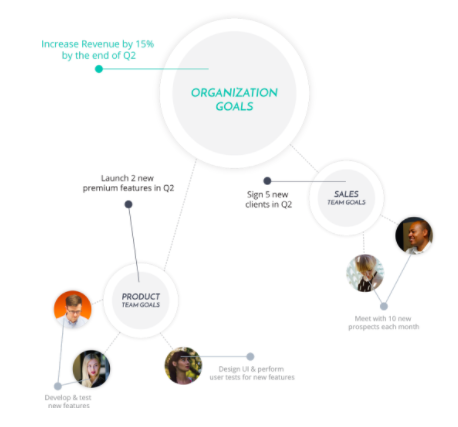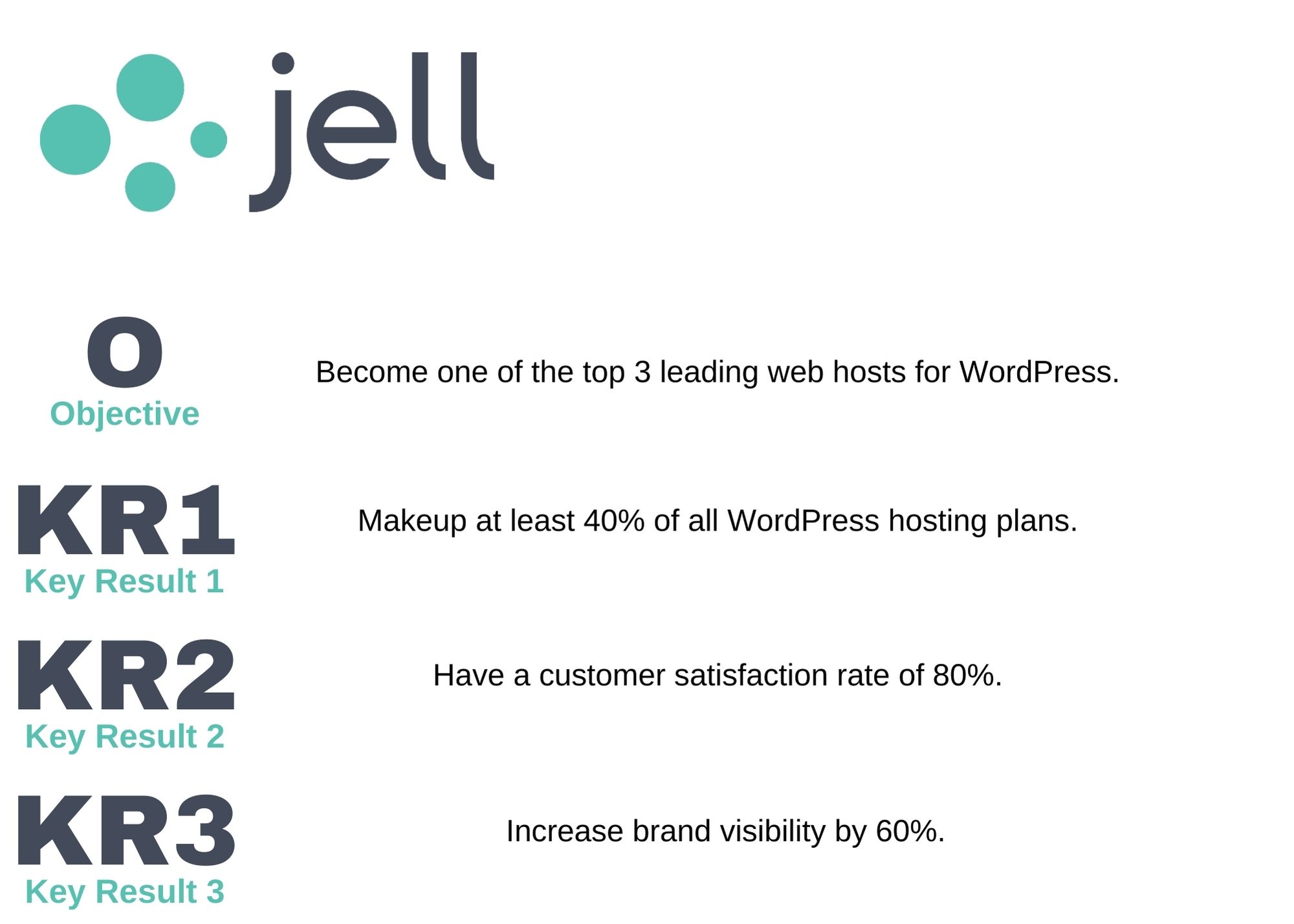If you’re lucky, you work with a company that implements an OKR strategy. When I first joined Jell I wondered what exactly they were and knew it couldn’t stand for “OK, Right?” In this post, we’ll go over how to write OKRs, what they are, why you should use them, examples, and tips for success.
We have an entire guide on getting started with OKRs. The key takeaway? Know what your end goals are. What do you need/want to accomplish at your company in order to move forward?For an engineering team, it might be creating a mobile app for a product. For a marketing team, it probably means getting more traffic, conversions, or higher average sales.For example, start with this goal:Objective: Increase daily active usersGreat start! But let’s make this more specific. Your new goal: increasing daily active users for your company’s product from 300 per day to 9000 per day over the course of the next six months, or for the next two quarters.How can we meet this goal? Start by breaking “OKRing” into objectives and key results over the course of two quarters. Start small. Maybe for the first quarter, set your goal to 4500 users, and gradually increase usage over the next 3 months.Please note: Generally, a founder, manager, or investor has come up with this goal, but everyone should know how to write objectives because all employees should have them.This is just a start. We’ll write a few more together throughout this article to take you from OKR novice to being OK at OKRs. OKR stands for Objectives and Key Results. The framework is a goal-setting tool measuring a team’s challenges and goals. OKRs assist a team with the proper tools to track progress, align strategies, and encourage team collaboration.OKRs are set monthly or quarterly. They’re more frequent than annual reviews, because workplace environments are fast-paced and quickly changing. OKRs adapt to these quick changes in an organization. They’re also transparent so that all departments are aligned with their goals.Unlike traditional objectives that start at the top and trickle down to the bottom, OKRs are bidirectional. They are set and every group or individual builds on these with their own measurable goals.And that’s what’s great: they’re highly collaborative. OKRs define each role in the organization and define how each role helps to achieve the objectives. Everyone has a role to play.
OKR stands for Objectives and Key Results. The framework is a goal-setting tool measuring a team’s challenges and goals. OKRs assist a team with the proper tools to track progress, align strategies, and encourage team collaboration.OKRs are set monthly or quarterly. They’re more frequent than annual reviews, because workplace environments are fast-paced and quickly changing. OKRs adapt to these quick changes in an organization. They’re also transparent so that all departments are aligned with their goals.Unlike traditional objectives that start at the top and trickle down to the bottom, OKRs are bidirectional. They are set and every group or individual builds on these with their own measurable goals.And that’s what’s great: they’re highly collaborative. OKRs define each role in the organization and define how each role helps to achieve the objectives. Everyone has a role to play. It’s important to note that not all objectives have a numerical value, objectives can be written in general terms. Though, all key results will include a number, as Marissa Mayer suggests.John Doerr, the creator of the OKR framework, actually uses this specific formula to write objectives and key results. We learned something similar in the paragraph above: I will ___ as measured by ___.So we can actually write our objective as:I will increase daily active users as measured by 4500 people using the app every business day.Since most objectives have multiple key results, we can extend this sentence by adding other measurements. These additions must pertain to the objective already listed.For example, these:
It’s important to note that not all objectives have a numerical value, objectives can be written in general terms. Though, all key results will include a number, as Marissa Mayer suggests.John Doerr, the creator of the OKR framework, actually uses this specific formula to write objectives and key results. We learned something similar in the paragraph above: I will ___ as measured by ___.So we can actually write our objective as:I will increase daily active users as measured by 4500 people using the app every business day.Since most objectives have multiple key results, we can extend this sentence by adding other measurements. These additions must pertain to the objective already listed.For example, these: Most companies have six-month or annual goals, but use quarterly OKR goals to keep you on track throughout the year. This isn’t difficult.
Let’s go back to the HR example to have a Net Promoter Score (NPS) of 38. In the first quarter, your objective is to get a baseline score. Let’s assume your company gets at least a 20 for the first survey. That means to hit your year-end goal of 38 you need to make up 18 points.So in quarter two, your objective might be to hit 26, then 32 in the third quarter, and 38 in the last.NPSs might mean nothing to you, but the point is to break up the goals into smaller pieces. The smaller, the more achievable the goal.You might also want to stretch each objective or key result so that you have room for missing your goal. This is common with OKRs, as many companies follow the thinking that OKRs will be hit 70-80% of the time. If you don’t hit it the other 20-30% of the time, it’s okay, because you’ve built this in.
Most companies have six-month or annual goals, but use quarterly OKR goals to keep you on track throughout the year. This isn’t difficult.
Let’s go back to the HR example to have a Net Promoter Score (NPS) of 38. In the first quarter, your objective is to get a baseline score. Let’s assume your company gets at least a 20 for the first survey. That means to hit your year-end goal of 38 you need to make up 18 points.So in quarter two, your objective might be to hit 26, then 32 in the third quarter, and 38 in the last.NPSs might mean nothing to you, but the point is to break up the goals into smaller pieces. The smaller, the more achievable the goal.You might also want to stretch each objective or key result so that you have room for missing your goal. This is common with OKRs, as many companies follow the thinking that OKRs will be hit 70-80% of the time. If you don’t hit it the other 20-30% of the time, it’s okay, because you’ve built this in. Your key results then cascade down to different team leads for the marketing, sales, and support departments as main objectives. Each department lead takes ownership of the key results relating to their department. Then, they craft their own department’s key results. A marketing manager might convert one of the original key results into their own OKR:
Your key results then cascade down to different team leads for the marketing, sales, and support departments as main objectives. Each department lead takes ownership of the key results relating to their department. Then, they craft their own department’s key results. A marketing manager might convert one of the original key results into their own OKR: Then, a marketing specialist makes their own OKR:
Then, a marketing specialist makes their own OKR: The cascading process results in sophisticated OKRs with top-down alignment. All employees know the chief executive’s top priorities. Everyone in the company feels involved and forwards the vision for the company. No person is left behind.
The cascading process results in sophisticated OKRs with top-down alignment. All employees know the chief executive’s top priorities. Everyone in the company feels involved and forwards the vision for the company. No person is left behind.
Jell Makes Obtaining OKR Goals Easy
Write OKRs, share progress, monitor success.
14-day free trial. No credit card required.
What are OKRs?
 OKR stands for Objectives and Key Results. The framework is a goal-setting tool measuring a team’s challenges and goals. OKRs assist a team with the proper tools to track progress, align strategies, and encourage team collaboration.OKRs are set monthly or quarterly. They’re more frequent than annual reviews, because workplace environments are fast-paced and quickly changing. OKRs adapt to these quick changes in an organization. They’re also transparent so that all departments are aligned with their goals.Unlike traditional objectives that start at the top and trickle down to the bottom, OKRs are bidirectional. They are set and every group or individual builds on these with their own measurable goals.And that’s what’s great: they’re highly collaborative. OKRs define each role in the organization and define how each role helps to achieve the objectives. Everyone has a role to play.
OKR stands for Objectives and Key Results. The framework is a goal-setting tool measuring a team’s challenges and goals. OKRs assist a team with the proper tools to track progress, align strategies, and encourage team collaboration.OKRs are set monthly or quarterly. They’re more frequent than annual reviews, because workplace environments are fast-paced and quickly changing. OKRs adapt to these quick changes in an organization. They’re also transparent so that all departments are aligned with their goals.Unlike traditional objectives that start at the top and trickle down to the bottom, OKRs are bidirectional. They are set and every group or individual builds on these with their own measurable goals.And that’s what’s great: they’re highly collaborative. OKRs define each role in the organization and define how each role helps to achieve the objectives. Everyone has a role to play.Why Use OKRs?
OKRs were Google’s ticket to industry success. OKRs help you clearly express your company’s goals. An objective is what needs to be accomplished. Ideally, they should be a measurable and succinct one-line statement. For every objective, there are 3-5 key results reflecting the path to accomplishment.Key results need to be specific and time bound. The more specific, the better. For example, turn “make more money” into “generate 10% more revenue by the end of Quarter Four.” Bold, trackable key results lead to successful objective completion.OKRs allow you to track your progress regularly. Regular can be anything from weekly, bi-weekly, to monthly, to any timeframe that works for you and your company’s needs. Tracking these objectives on a Google Sheet that every employee has access to works well. We offer templates as guides for where to start. Have your employees met all your OKRs for that period? Throw a party! Call out everyone’s good work and celebrate your employees’ accomplishments.OKRs help you analyze and grow. Like your company, OKRs are ever-changing, evolving with your company’s needs. Those needs change depending on the quarter and what happens in any given period of time. Add, delete, revise accordingly. Don’t use OKRs as inflexible and don’t hold onto irrelevant goals. Constantly change and evaluate. Take the opportunity to assess what went wrong and ask questions. Were your objectives a bit too ambitious? How can you clarify your key results knowing what you know now? OKRs grant the opportunity to grow and change, committing to daring objectives with more aggressive results.The Main Parts of an OKR
Let’s review the components of an OKR. Everyone needs a good refresher.OKRs all follow the same template.- I will [objective] as measured by [key result].
How to Write Objectives: Suggestions from Experts
 It’s important to note that not all objectives have a numerical value, objectives can be written in general terms. Though, all key results will include a number, as Marissa Mayer suggests.John Doerr, the creator of the OKR framework, actually uses this specific formula to write objectives and key results. We learned something similar in the paragraph above: I will ___ as measured by ___.So we can actually write our objective as:I will increase daily active users as measured by 4500 people using the app every business day.Since most objectives have multiple key results, we can extend this sentence by adding other measurements. These additions must pertain to the objective already listed.For example, these:
It’s important to note that not all objectives have a numerical value, objectives can be written in general terms. Though, all key results will include a number, as Marissa Mayer suggests.John Doerr, the creator of the OKR framework, actually uses this specific formula to write objectives and key results. We learned something similar in the paragraph above: I will ___ as measured by ___.So we can actually write our objective as:I will increase daily active users as measured by 4500 people using the app every business day.Since most objectives have multiple key results, we can extend this sentence by adding other measurements. These additions must pertain to the objective already listed.For example, these:- I will increase daily active users as measured by getting 10,000 website installs each month.
- I will increase daily active users as measured by increasing website traffic to 20,000 visits per month.
Human Resources Example
Let’s pretend you work in HR and have 500 employees. In past positions, you’ve found that improving employee sentiment has directly impacted turnover rates and employee referrals.Over the next year, you’ve been given the task of rolling out employee NPS (Net Promoter Score) surveys and establishing it at an acceptable market average of 38.Your objective and key results might be as follows:Objective: Implement an NPS as measured by- getting 400 employees to answer the first survey
- working with 23 managers to relay the importance of the employee survey and
- hosting 1 employee event displaying overlooked benefits for the company.
- Key Result: Get 20% more employees to sign up for 401K contributions
- Key Result: Send 2 monthly emails outlining popular benefits that should be taken advantage of, such as discounts or memberships
- Key Result: Host quarterly benefits workshop where you educate and assist employees in signing up or using benefits
Sales Team Example
Now let’s move into Salesland. You’re a sales manager and you want to roll out a CRM (customer relationship management is a service for managing your company’s relationships and interactions with customers and prospects) system. Your team hasn’t ever had a CRM before, and they were structured more like a support team. Now you want to move them into the big leagues, to bigger and better sales for the company. Over the next two quarters, your task is to implement this CRM and educate your sales team on it. Your objective and key results might be as follows:Objective: Roll out a CRM by Quarter 2.- Audit different CRMs and make a list of (3) you find best.
- Establish a budget for the CRM.
Related Articles
Free OKR Template – How to Set Objectives and Key Results
Concrete Tips for Getting Started with OKRs
How to Use Stretch Goals with OKRs
Write OKRs By Breaking Goals Into Quarterly Objectives
 Most companies have six-month or annual goals, but use quarterly OKR goals to keep you on track throughout the year. This isn’t difficult.
Let’s go back to the HR example to have a Net Promoter Score (NPS) of 38. In the first quarter, your objective is to get a baseline score. Let’s assume your company gets at least a 20 for the first survey. That means to hit your year-end goal of 38 you need to make up 18 points.So in quarter two, your objective might be to hit 26, then 32 in the third quarter, and 38 in the last.NPSs might mean nothing to you, but the point is to break up the goals into smaller pieces. The smaller, the more achievable the goal.You might also want to stretch each objective or key result so that you have room for missing your goal. This is common with OKRs, as many companies follow the thinking that OKRs will be hit 70-80% of the time. If you don’t hit it the other 20-30% of the time, it’s okay, because you’ve built this in.
Most companies have six-month or annual goals, but use quarterly OKR goals to keep you on track throughout the year. This isn’t difficult.
Let’s go back to the HR example to have a Net Promoter Score (NPS) of 38. In the first quarter, your objective is to get a baseline score. Let’s assume your company gets at least a 20 for the first survey. That means to hit your year-end goal of 38 you need to make up 18 points.So in quarter two, your objective might be to hit 26, then 32 in the third quarter, and 38 in the last.NPSs might mean nothing to you, but the point is to break up the goals into smaller pieces. The smaller, the more achievable the goal.You might also want to stretch each objective or key result so that you have room for missing your goal. This is common with OKRs, as many companies follow the thinking that OKRs will be hit 70-80% of the time. If you don’t hit it the other 20-30% of the time, it’s okay, because you’ve built this in.Use A Tool To Set OKRs
It might be difficult to write OKRs when you can’t visualize a system to do it. But you can use a tool to help you set and monitor OKRs overtime.This will give you the mental reminders and dedicated place to look at your goals, edit them (if needed), plan for the future, and see where you stand in respect to your quarterly objectives. Need help writing OKRs? No problem. We have an OKR eBook.You’ll learn:- How to select goal-producing results
- How to incorporate OKRs into your workplace
- How to analyze the success of your goals
How to Cascade top-down OKRs
As we mentioned earlier, OKRs are bidirectional. Once you’ve learned to write a traditional OKR, you’re ready to move on to an intermediate technique: cascading OKRs to align teams and employees across your company to work towards the same goals. Without aligning goals, separate departments and employees can pull too many resources from different directions. By cascading the OKRs, a company can maximize performance by moving forward together. Choosing the right cascading technique depends on the needs of your company. Bottom-up OKRs are best used when an organization wants to increase innovation. Whereas top-down is most effective when organizations are in crisis or is prioritizing specific objectives. It works like this: top OKRs flow downwards to department leads, managers, and individual employees who take ownership of key results from those above their level in an organization. Then, they decide the best way to achieve these objectives. Again, it’s bi-directional. It’s important that the top takes input from below. Those closer to the bottom have an idea of how to make an organization’s objectives turn from dream to reality. This can look like:- Quarterly meeting where high-level OKRs are written by the company execs, then introduced to the whole company.
- Department managers take these OKRs and write their own based on the company’s top objectives.
- They write key results decided on by the execs as their own objectives.
- Then, members of each department write their own OKRs based on their manager’s goals.
Cascading top-down examples
Pretend you’re the owner of a web hosting company. You set the following OKRs: Your key results then cascade down to different team leads for the marketing, sales, and support departments as main objectives. Each department lead takes ownership of the key results relating to their department. Then, they craft their own department’s key results. A marketing manager might convert one of the original key results into their own OKR:
Your key results then cascade down to different team leads for the marketing, sales, and support departments as main objectives. Each department lead takes ownership of the key results relating to their department. Then, they craft their own department’s key results. A marketing manager might convert one of the original key results into their own OKR: Then, a marketing specialist makes their own OKR:
Then, a marketing specialist makes their own OKR: The cascading process results in sophisticated OKRs with top-down alignment. All employees know the chief executive’s top priorities. Everyone in the company feels involved and forwards the vision for the company. No person is left behind.
The cascading process results in sophisticated OKRs with top-down alignment. All employees know the chief executive’s top priorities. Everyone in the company feels involved and forwards the vision for the company. No person is left behind.Wrap Up: Things to Keep in Mind About How to Write Objectives & Key Results
- Use John Doerr’s formula: I will ___ as measured by ___.
- Remember that most key results should include a number.
- Everyone on your team should know how to write OKRs.
- Each team member will have multiple objectives, and 3-5 key results.
- Write OKRs by breaking up year long goals.
- Overestimate your OKRs.
- Use a tool to set and monitor OKRs.
